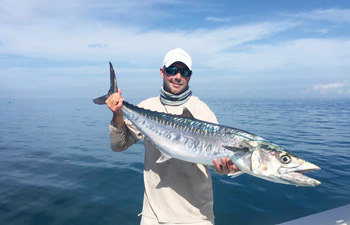Spring’s in full swing

submitted
Captain Justin Moore holds a large king he caught off Anna Maria Island.
When kingfish and cobia enter local waters in numbers, it heralds the arrival of spring with the portent that summer isn’t far behind. These fish and almost every species that swims local waters can be targeted this time of the year. Kingfish in particular, provide electrifying action to area anglers. While kings may appear earlier, generally when the water temperature reaches 70 degrees, they migrate into inshore water in search of baitfish. This year that magic number was reached early.
Kingfish are very aggressive, and will hit a wide variety of live baits, plugs, spoons, feathered jigs and flies. In the past kings were pursued with heavy tackle, but light tackle has become much more popular. Lighter tackle will provide more hook ups and is a lot more challenging and fun. A 20-pound outfit is more than adequate, and many anglers pursue kings with gear as light as 8 pounds. In the open Gulf, with the exception of crab trap markers, kings are seldom lost to structure, so the most important consideration is rigging. Kingfish hit hard and make long runs. Aside from the need for a smooth drag, the major consideration is a sharp hook and protection from their razor sharp teeth.
Anglers fishing for kings generally employ an 8- to 12-inch strand of wire. Fly fishermen and those who use live bait also can use wire or substitute extra-long shank hooks and monofilament leader. They’ll get more hits with mono leaders and more cut-offs, but I prefer the action. Wire can spook fish in clear water and is best used in low light situations – on cloudy days, early mornings and late afternoons. The best wire I’ve found include products like those made by American Fishing Tackle. Their wire is constructed with seven strands of stainless steel, can be tied like mono, is easy to work, kinks less and can be tied like monofilament.
The best way to locate kingfish is to find the schools of baitfish they pursue.
Structure in the Gulf (wrecks, patch reefs, ledges) and, as the waters warm, the edges of the local passes, are prime areas. A loran and fish-finder are great assets in the search, but anglers who don't have this equipment can target kings by locating baitfish and breaking fish. The action will usually have a contingent of pelicans and terns overhead. While live baiting usually takes the largest fish, trolled plugs, spoons, feathers and flies are all effective.
The most effective way to attract kings is by deploying a chum bag and then chum with dead and live bait. Position your boat near structure, live bottom, baitfish schools or feeding birds. After a chum line has been established, begin adding pieces of cut bait, and finally, a few live shiners to the water. Slow trolling ladyfish and blue runners can also be effective if shiners are scarce.
If you prefer not to chum, locate schools of bait fish on the surface and work the edges by drifting or with the aid of a trolling motor. A quiet approach will avoid spooking the baitfish, kingfish and other predators that may be patrolling the area. Cast to the edges of the school where kingfish patrol looking for wounded prey.
One way to target kings that is very effective is top water plugs and big top water flies. There is nothing quite like a big king trashing a plug or fly on the surface. The bigger and nosier the fly or plug, the better. Whether you seek out kingfish on flies, live bait or trolling, you’re in for some of the most exciting action to be found off our coast. Rig light, protect from the kings’ sharp teeth and hold on!

